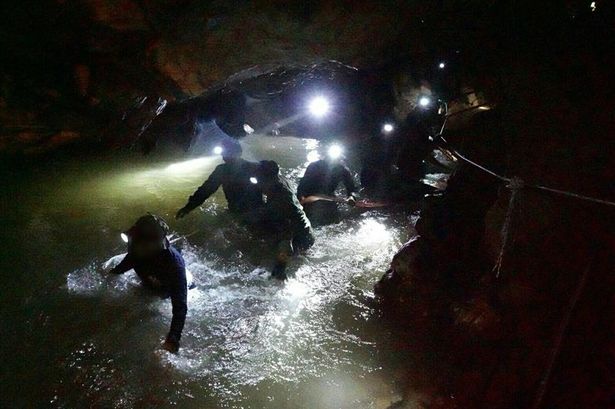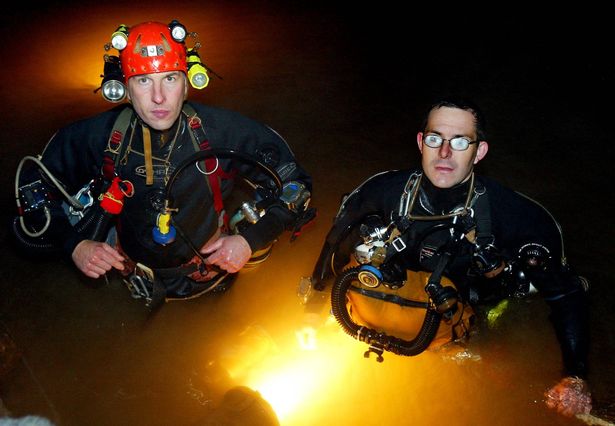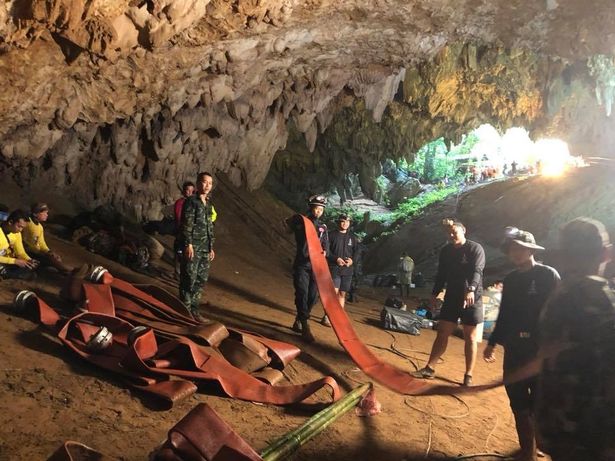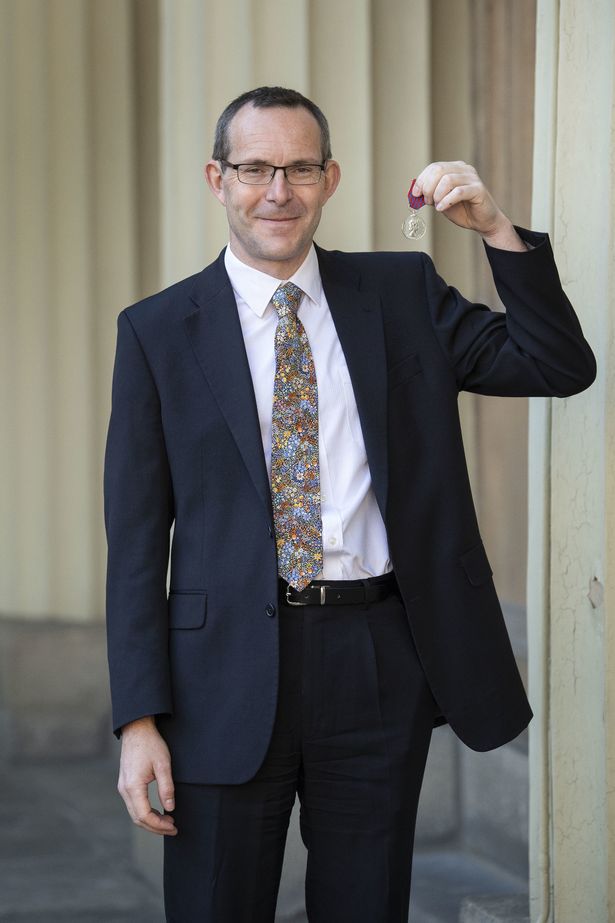‘I led nail-biting cave rescue of Thai soccer team – we feared we’d never see them alive’ – World News
It was the smell that made John Volanthen fear the worst when he first came up for air.
Turning to his companion Rick Stanton, the diver assumed it was the odour of rotting corpses – in fact, it belonged to a rather pungent make-shift toilet spot a mile inside the cavernous Thai cave they were desperately searching.
“If you’ve got to pick something to smell, it’s much better to have that and see 12 Thai kids alive,” quips the 49-year-old now.
It was just one of the countless surreal moments in a rescue mission that gripped the world, as everyone from the US military to Elon Musk piled in to save the Wild Boars soccer team trapped against a rising tide.
A world-renowned cave diver for 30 years, John and two fellow Brits were parachuted in to spearhead the operation – battling against insurmountable odds to retrieve the entire group alive and well.
In his new book, Thirteen Lessons That Saved Thirteen Lives, John reveals the nail-biting moments that left him preparing for the worst – from sedating the boys with ketamine to the exhausting swim for survival.
‘I imagined bumping into bodies’
John first realised his services were in order when he read the story on BBC news: 12 young soccer players and their coach had become trapped in the Tham Luang Nang Non cave after venturing in for an initiation ceremony on June 23, 2018.
Contacting fellow Brit Vernon Unsworth, who was already at the scene, John and Rick flew out to Thailand – but the operation was already growing out of control.
“When we arrived there was a fair bit of chaos,” says John. “Lots of organisations were milling round, nobody actually seemed to know what they had to do. On top of that, the water had been rising steadily, advancing towards the entrance to the cave.”

(Image: Thai Navy SEAL via Getty Images)
Earning the trust of the US military who were plotting the mission alongside the Thai Navy Seals, the Brits took a step back and assessed their options.
With the water reaching dangerously high levels, there was little to do but wait for days until they could enter the cave.
As the press poured in from across the globe, the forces on the ground contemplated the grim reality of the situation – with the flooding so severe, there was little chance the football team would be alive.
“I tend to do a lot of visualisations,” says John, from Bristol, who has previously carried out cave diving missions in body recovery.
“In my mind I had run through crawling underwater upstream against the flow, reaching a swirling point of the cave and quite literally bumping into children’s bodies, imagining how they might spin in the flow.
“It’s a macabre thing to do, but I’d rather ready myself for it ahead of time than find it and be unprepared for it. It’s a case of hoping for the best, but preparing for the worst.”
During their first expedition into the cave, however, John and Rick were surprised to come across another team – four Thai water workers who had become trapped during an earlier rescue attempt.
Quickly deciding to take them to safety, the Brits tucked the workers under their arms in a manoeuvre John likens to an “underwater wrestling match”.
Yet the bizarre discovery paled in comparison to what they found next.
‘Finding them alive? That was the easy part’
On July 1 – a week since the alarm was raised – the waters had finally reached a safe enough level for John and Rick to search the cave further.
Venturing a mile in, the pair eventually emerged into an opening. At first, they were hit by the terrible smell – but then noticed flashes of light bouncing around the pitch-black chamber. They had found the Wild Boars.

(Image: X00514)
Armed with cameras to record the journey and provide proof of life, Rick inspected the faces in complete disbelief.
“I hadn’t expected all the children to survive. I wanted to capture the faces of those who were alive so we could work out who was not,” he explains.
“Once we finished filming, we counted to 13 and they were all alive. Unbelievable. On the video, as I start climbing the mud bank where they’re sheltering, there’s a funny moment where I say a couple of times ‘believe’. I’m just trying to convince myself that the situation really is real.”
When the news broke of the boys’ survival, millions breathed a sigh of relief. But John couldn’t afford to be so complacent – he knew the hardest leg of their journey was yet to come.
“What we were trying to do had never been done before,” he says. “It’s almost unimaginable in a modern western society that you can have 12 happy, smiley children that are beyond help.
“Yet, I’ve always known that in cave diving explorations, you can be beyond a long, flooded section of cave and you can be alive there, but you’re slowly dying. There’s no way of sustaining life.
“To explain that concept is quite difficult, as people didn’t want to hear that. Because we’d found them, people seemed to think it was a done deal. Really, it hadn’t been started.”
Emerging back alone from the cave, the divers began plotting how to rescue the team and their coach.
John knew that if they stayed there much longer, with oxygen quickly depleting, not one of them would survive.

(Image: SWNS)
While the experts ignored the buzz of the international media, hundreds of offers of help were coming from all corners of the globe.
Notably, one such offer was from Tesla founder Elon Musk, who rang them suggesting he could supply a small submarine to assist the operation.
John, a self-confessed fan of the billionaire’s work, urged his colleagues to hear him out.
“I said to Rick, ‘This is a person with almost limitless resources. We would be foolish to turn down this assistance.’ It seemed that if anyone was going to pull of some sort of wild card, he had the experience, the money and the engineering to do so.
“Ultimately it wasn’t something that would have been useful. But there were hundreds of people offering suggestions and if you have to pick someone that’s credible, he was probably very high up on that list.”
Musk’s involvement took a infamous turn once his help was turned down. The billionaire took to Twitter calling Vernon a “pedo guy”, leading to a highly-publicised defamation suit he eventually won.
“I wasn’t involved in the name calling and stuff that happened afterwards,” says John. “It was a shame really as it detracted from the whole rescue mission.”
Boys drugged with ketamine
The divers’ previous rescue of the water workers had taught them one key lesson as they made preparations to retrieve the soccer team.
Even in that short journey back, the workers had struggled against the water and risked losing sight of the navigation line.
The solution was a sobering one: the boys would have to be sedated.

Video Unavailable
“We knew that there was no way we could bring the boys out conscious through a mile of flooded passage,” says John.
“At some point they would panic, and that had been underlined by bringing these adult male water workers from what was perhaps 80 metres of passage.”
Bringing in expert anaesthetist Richard Harris, the team were armed with a mixture of ketamine, xanax and atropine.
The rescue mission was ready to go.
‘We put them underwater – and they stopped breathing’
Emerging in the cave chamber, John was handed the responsibility of bringing three of the children to safety.
Initially believing they might be semi-conscious for the journey, he now knew he would have to carry them completely unconscious.
Upon administering the drugs, however, they were faced with a terrifying moment before the journey had even begun.

(Image: Thai Navy SEAL via Getty Images)
“When we put the children’s faces underwater they stopped breathing for a period of time,” says John.
“Perhaps it was the cold water, but they would tense up, then start relaxing. I certainly had an issue with my second lad where he stopped breathing for some period of time.
“It’s not a good situation to be in. You’ve got a healthyish child and because you’re so far from help, you’re on your own.”
Feeling completely exhausted after days of non-stop preparations, the diver admits at that moment he “desperately wanted it to be over”.
Strapping on the children’s masks, though, he broke the journey ahead into small checkpoints in his mind – then took the plunge.
“I was overwhelmingly tired and as is often the case with difficult things in all walks of life, the whole problem is too much to think about,” John says of the journey back.
“I tend to break things down into small chunks and it’s just a case of moving forwards, one step at a time and ticking those little jobs off.
“The visibility is often so bad that you can’t see the child you’re carrying. You’ve got one hand on the line, you’re cradling the child under your chest. The only way you know they’re still alive is that you can feel bubbles rising from the regulator attached to their mask.”

(Image: AFP/Getty Images)
The eyes of the world were fixated on the divers, but John says he simply focused on the three boys under his care.
If there was a mistake to be made on this mission, he vowed, it wouldn’t be his.
Swimming through what he describes as “cold coffee”, he took care to guide the unconscious children’s bodies while not disturbing their masks, which could have led to them drowning on the spot.
Just metres from the exit, he came across a heart-stopping problem.
“I suddenly had a moment quite close to the end of the dive where suddenly the child wouldn’t move forwards,” says John.
“In the poor visibility I had to park him on the bottom and feel down the side of his body, looking for a reason why he wouldn’t move forwards.
“I found a piece of old telephone wire that had wound round one of his legs, so I had to cut that. All of this is done in visibility of perhaps six inches.”
Played by Colin Farrell in Hollywood blockbuster
The final result was a triumph against all odds. By July 10, all 12 boys and the coach were rescued alive and taken to hospital for treatment.
Reflecting on his team’s success, John admits his own sense of relief was in being able to “hold my head up high” – albeit in typically macabre fashion.
“Quite often if you recover bodies, the relatives want to thank you for doing that and that’s part of their healing process,” he says.
“I’ve had to say ‘I’m sorry for your loss’ quite a lot. I was just very pleased not to have to meet a parent of a Wild Boar and say that. It might sound a bit negative, but I could hold my head up high. We did what we said we could do.”

(Image: Getty Images)
Since their famous great escape, the divers’ stories have been pounced on by publishers and movie producers.
John’s new book, Thirteen Lessons That Saved Thirteen Lives, tells of the operation in heart-stopping detail, while also sharing the coping techniques he employed which can be used in everyday life.
The mission is also being made into a National Geographic documentary by the directors of Free Solo, while John is consulting on a $55million blockbuster directed by Oscar-winner Ron Howard that is due to be released next year.
To his own amusement, the diver has found himself holding Zoom sessions with none other than Hollywood star Colin Farrell – who is playing John.
“The worst that’s going to happen is that I look like a hunky Irishman,” he laughs.
“I did used to say to Ron Howard, ‘What about Rowan Atkinson?’ But he made it very clear that he’s not making that kind of movie. I don’t think he was very impressed with my suggestion!”
The accolades have kept coming for John and his team. In 2018, the Brits were invited to Downing Street to meet then-prime minister Theresa May.
The following year, he was also awarded the George Medal by the Queen.
“I was quite taken aback by the George Medal,” he admits. “If you look at other recipients of the George Medal, I think they’re far more deserving than me in terms of the level of risk and danger. Similarly, I appreciated the gesture of going to Downing Street.
“But live carries on, I’ve still got a mortgage to pay. I feel very comfortable that I know who I am. I know where I sit in life and I’m very comfortable in a dirty hole – preferably if it has water in it.”
Thirteen Lessons that Saved Thirteen Lives by John Volanthen is published by Aurum on 1 June.


